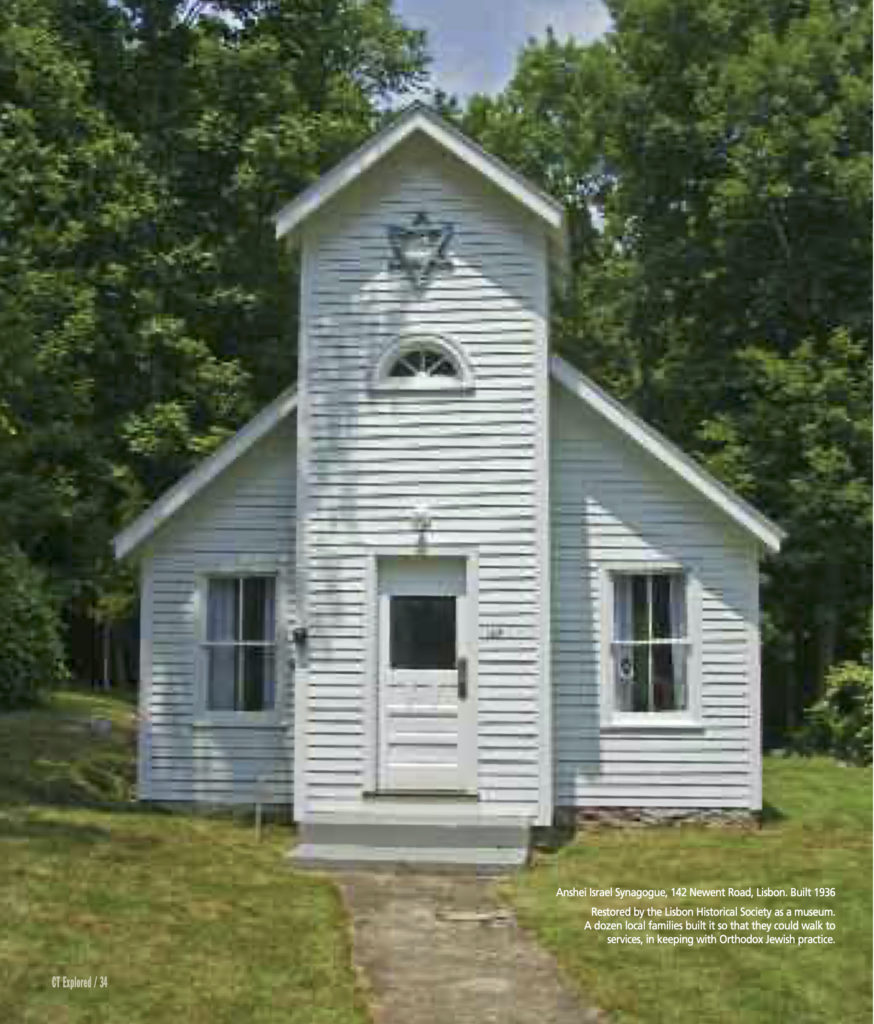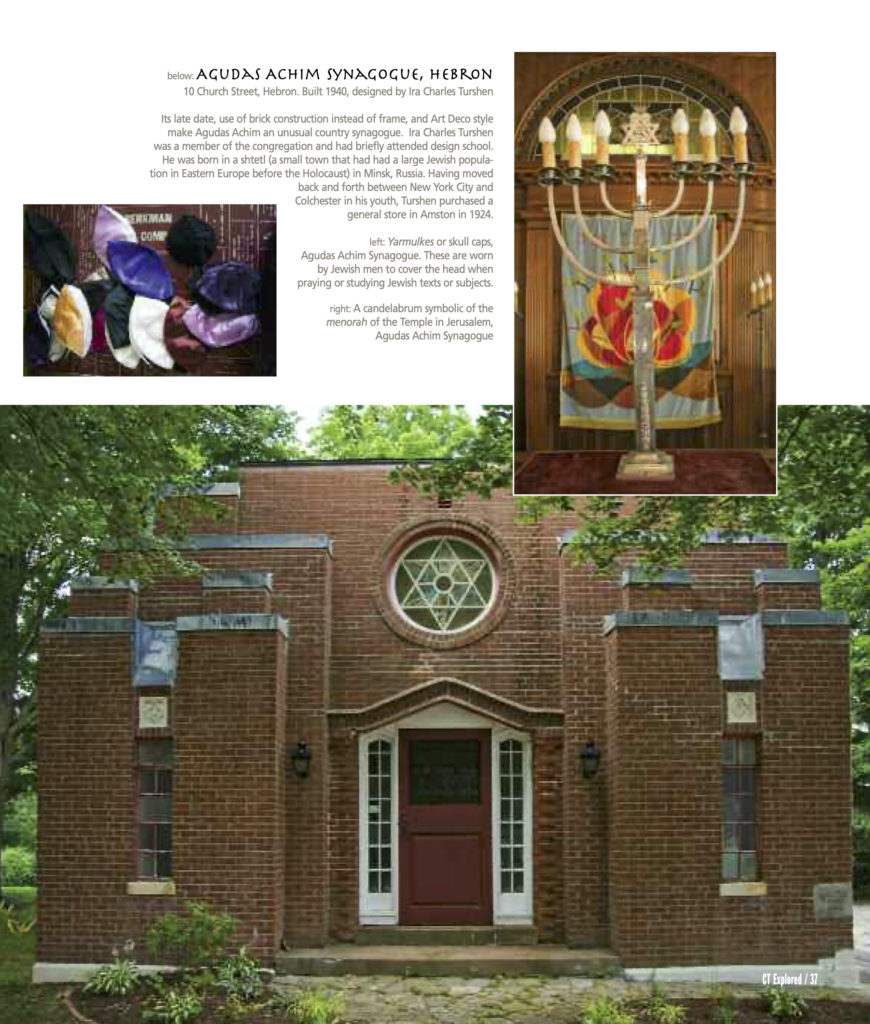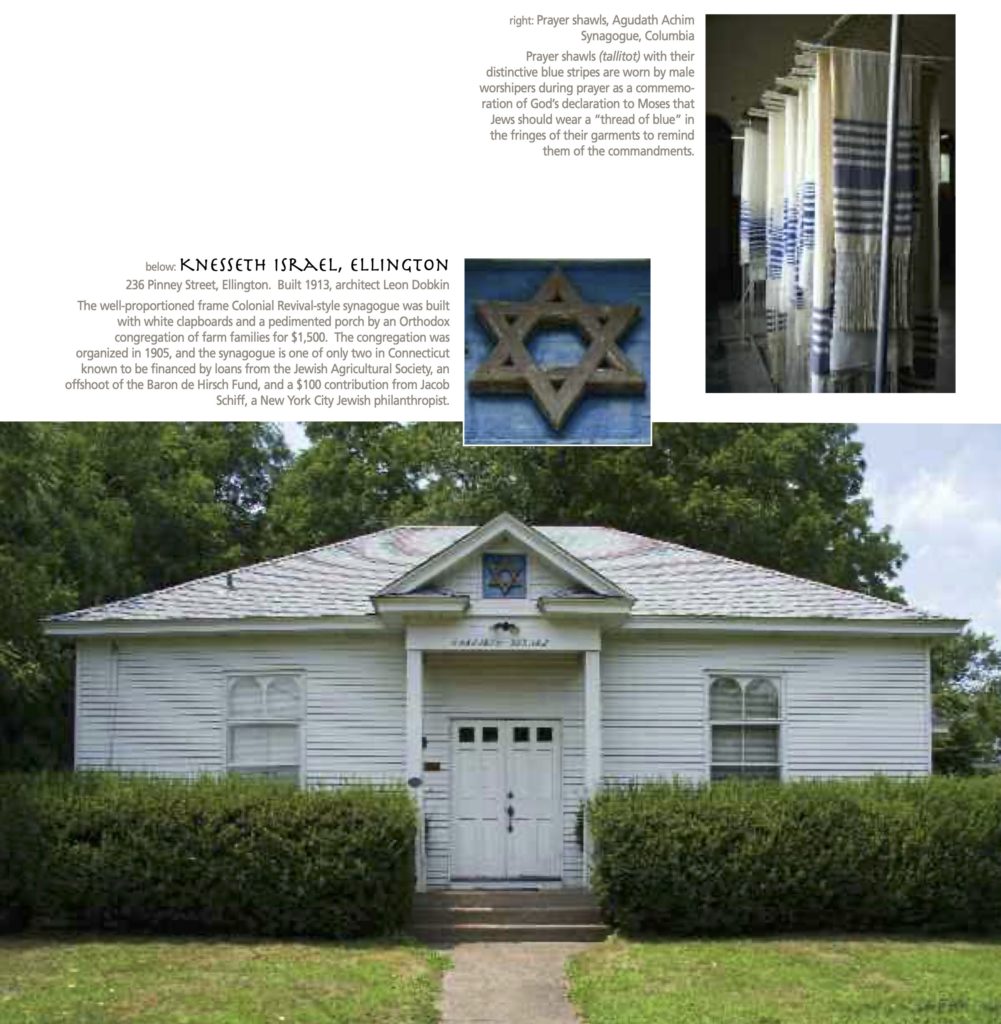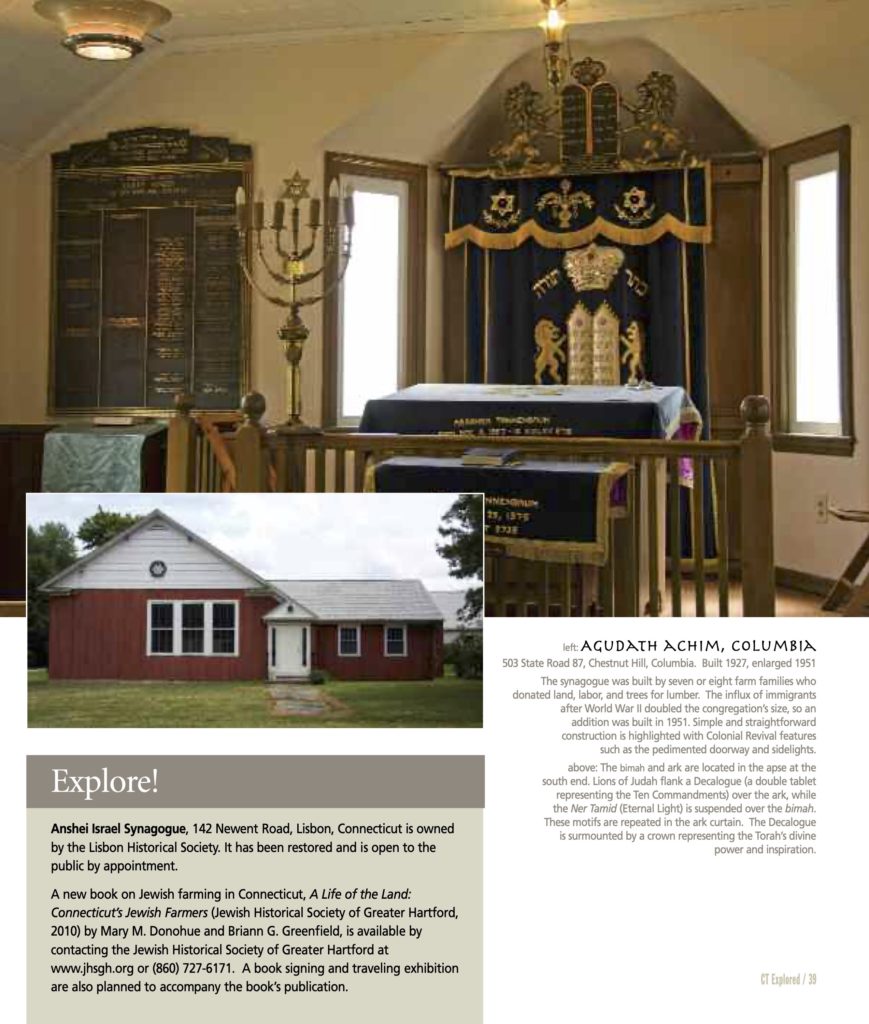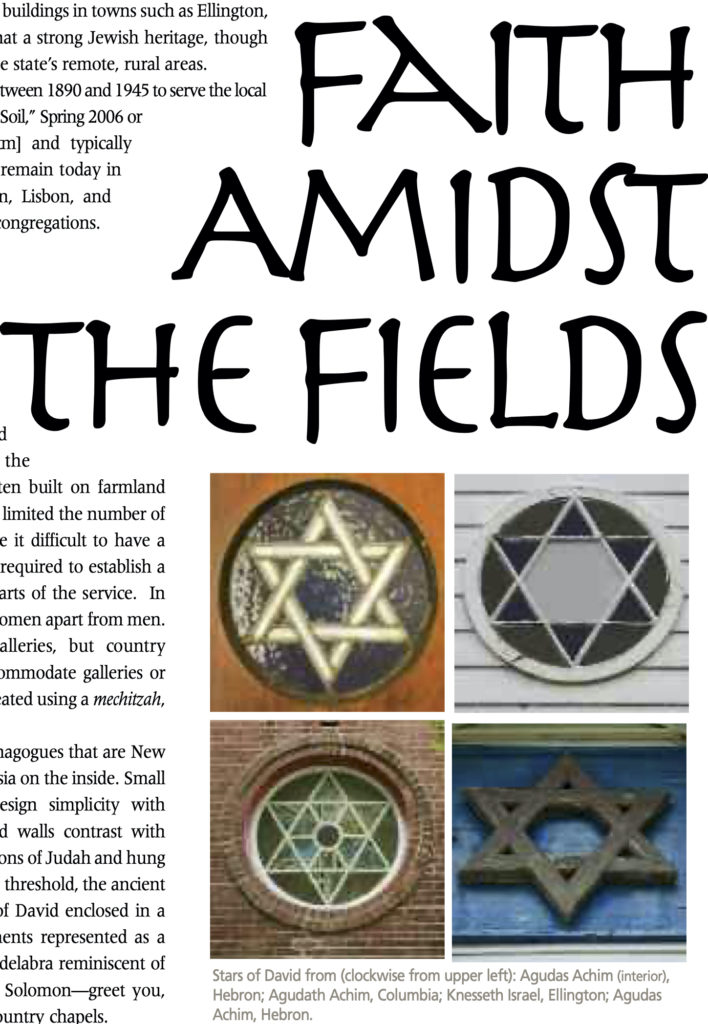
Stars of David from (clockwise from upper left): Agudas Achim (interior), Hebron; Agudath Achim, Columbia; Knesseth Israel, Ellington; Agudas Achim, Hebron. photos: Robert Gregson
Text by Mary M. Donohue and photography by Robert Gregson
(c) Connecticut Explored Inc. Winter 2010/2011
Subscribe/Buy the Issue!
When we think of the New England countryside, images of stone walls, one-room schoolhouses, and town greens come to mind. We don’t usually think of the Star of David, but in Connecticut, tiny synagogue buildings in towns such as Ellington, Lisbon, and Columbia serve to remind us that a strong Jewish heritage, though nearly hidden from sight, thrived even in the state’s remote, rural areas.
These plain country synagogues were built between 1890 and 1945 to serve the local farming community [see “Hebrew Tillers of the Soil,” Spring 2006]and typically served Orthodox congregations. Examples remain today in Columbia, East Haddam, Ellington, Hebron, Lisbon, and Newtown; three are still actively serving congregations. Others are gone, including the earliest known example in Chesterfield, built in 1890 and lost to a deliberately set fire in 1975.
Traditional Judaic religious practice adheres to many strict requirements that made sustaining a rural congregation challenging. For example, observances forbid transportation other than walking on the Sabbath. As country synagogues were often built on farmland donated by one of the congregants, this rule limited the number of families that could get to services and made it difficult to have a minyan, the quorum of 10 adult male Jews required to establish a congregation and for recitation of certain parts of the service. In addition, standard Orthodox practice seats women apart from men. Normally such separate seating is in galleries, but country synagogue buildings were too small to accommodate galleries or balconies, so separate sections were often created using a mechitzah, a curtain-like partition to divide the space.
The photos that follow show country synagogues that are New England on the outside and a little bit of Russia on the inside. Small jewel-like interiors combine American design simplicity with eastern-European ornateness. Plain painted walls contrast with gilded arks surmounted with hand-carved Lions of Judah and hung with red-velvet curtains. Once you cross the threshold, the ancient symbols of Judaism—the six-pointed Star of David enclosed in a circle, the Decalogue, the Ten Commandments represented as a double tablet, and the menorah, with a candelabra reminiscent of those in the Tabernacle and the Temple of Solomon—greet you, making it clear that these are no ordinary country chapels.
Anshei Israel, Lisbon
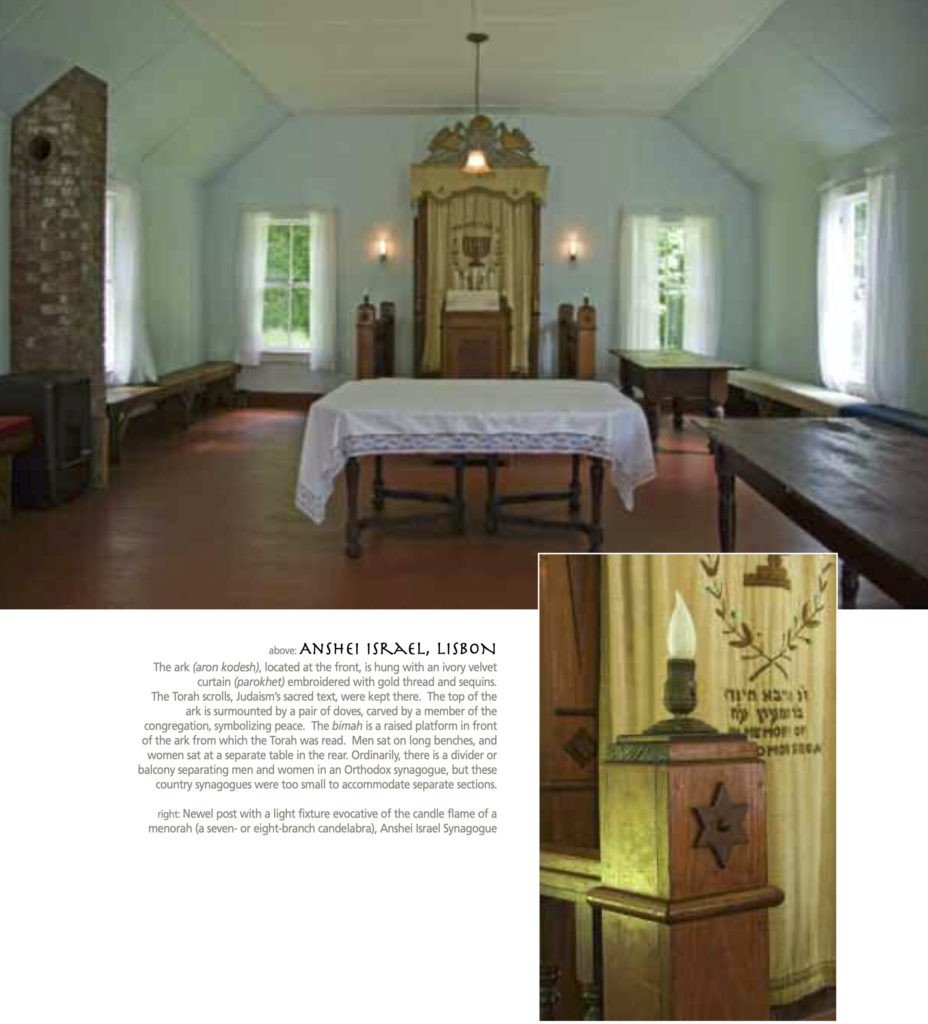 The ark (aron kodesh), located at the front, is hung with an ivory velvet curtain (parokhet) embroidered with gold thread and sequins. The Torah scrolls, Judaism’s sacred text, were kept there. The top of the ark is surmounted by a pair of doves, carved by a member of the congregation, symbolizing peace. The bimah is a raised platform in front of the ark from which the Torah was read. Men sat on long benches, and women sat at a separate table in the rear. Ordinarily, there is a divider or balcony separating men and women in an Orthodox synagogue, but these country synagogues were too small to accommodate separate sections.
The ark (aron kodesh), located at the front, is hung with an ivory velvet curtain (parokhet) embroidered with gold thread and sequins. The Torah scrolls, Judaism’s sacred text, were kept there. The top of the ark is surmounted by a pair of doves, carved by a member of the congregation, symbolizing peace. The bimah is a raised platform in front of the ark from which the Torah was read. Men sat on long benches, and women sat at a separate table in the rear. Ordinarily, there is a divider or balcony separating men and women in an Orthodox synagogue, but these country synagogues were too small to accommodate separate sections.
right: Newel post with a light fixture evocative of the candle flame of a menorah (a seven- or eight-branch candelabra), Anshei Israel Synagogue
Agudas Achim Synagogue, Hebron
10 Church Street, Hebron. Built 1940, designed by Ira Charles Turshen
Its late date, use of brick construction instead of frame, and Art Deco style make Agudas Achim an unusual country synagogue. Ira Charles Turshen was a member of the congregation and had briefly attended design school. He was born in a shtetl (a small town that had had a large Jewish population in Eastern Europe before the Holocaust) in Minsk, Russia. Having moved back and forth between New York City and Colchester in his youth, Turshen purchased a general store in Amston in 1924.
left: Yarmulkes or skull caps, Agudas Achim Synagogue. These are worn by Jewish men to cover the head when praying or studying Jewish texts or subjects.
right: A candelabrum symbolic of the menorah of the Temple in Jerusalem, Agudas Achim Synagogue
below right: Prayer shawls, Agudath Achim Synagogue, Columbia [see below]
Prayer shawls (tallitot) with their distinctive blue stripes are worn by male worshipers during prayer as a commemoration of God’s declaration to Moses that Jews should wear a “thread of blue” in the fringes of their garments to remind them of the commandments.
Knesseth Israel, Ellington
236 Pinney Street, Ellington. Built 1913, architect Leon Dobkin
The well-proportioned frame Colonial Revival-style synagogue was built with white clapboards and a pedimented porch by an Orthodox congregation of farm families for $1,500. The congregation was organized in 1905, and the synagogue is one of only two in Connecticut known to be financed by loans from the Jewish Agricultural Society, an offshoot of the Baron de Hirsch Fund, and a $100 contribution from Jacob Schiff, a New York City Jewish philanthropist.
Agudath Achim, Columbia
503 State Road 87, Chestnut Hill, Columbia. Built1927, enlarged1951
The synagogue was built by seven or eight farm families who donated land, labor, and trees for lumber. The influx of immigrants after World War II doubled the congregation’s size, so an addition was built in 1951. Simple and straightforward construction is highlighted with Colonial Revival features such as the pedimented doorway and sidelights.
below: The bimah and ark are located in the apse at the south end. Lions of Judah flank a Decalogue (a double tablet representing the Ten Commandments) over the ark, while the Ner Tamid (Eternal Light) is suspended over the bimah. These motifs are repeated in the ark curtain. The Decalogue is surmounted by a crown representing the Torah’s divine power and inspiration.
Mary M. Donohue is the survey and grants director of the Connecticut Commission on Culture & Tourism (CCT), co-author of A Life of the Land: Connecticut’s Jewish Farmers, and a frequent contributor to Connecticut Explored. She serves on the Connecticut Explored editorial team and most recently wrote “A Hip Road Trip” for the Winter 2009/2010 issue.
Robert Gregson is the creative director for the CCT and an artist. He most recently wrote and provided the photographs for “Modernism in Connecticut,” Winter 2009/2010 and images for “Discovering Lagardo Tackett” in this issue.
Explore!
“Hebrew Tillers of the Soil,” Spring 2006
“The Connecticut Catskills,” Summer 2018
“Jews in Hartford: Making Their Presence Known,” Summer 2005
Read more Historic Preservation stories on our TOPICS page.

